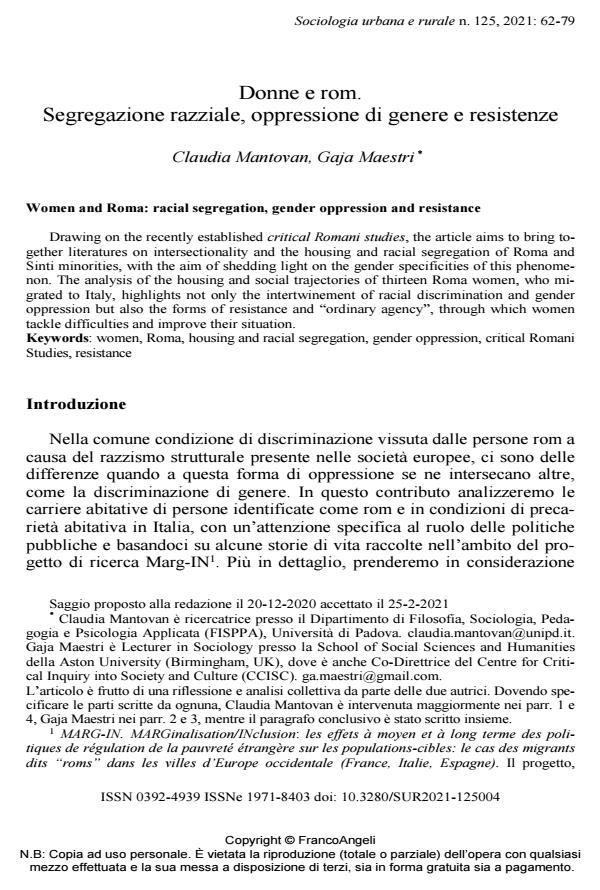Donne e rom. Segregazione razziale, oppressione di genere e resistenze
Titolo Rivista SOCIOLOGIA URBANA E RURALE
Autori/Curatori Claudia Mantovan, Gaja Maestri
Anno di pubblicazione 2021 Fascicolo 2021/125
Lingua Italiano Numero pagine 18 P. 62-79 Dimensione file 309 KB
DOI 10.3280/SUR2021-125004
Il DOI è il codice a barre della proprietà intellettuale: per saperne di più
clicca qui
Qui sotto puoi vedere in anteprima la prima pagina di questo articolo.
Se questo articolo ti interessa, lo puoi acquistare (e scaricare in formato pdf) seguendo le facili indicazioni per acquistare il download credit. Acquista Download Credits per scaricare questo Articolo in formato PDF

FrancoAngeli è membro della Publishers International Linking Association, Inc (PILA)associazione indipendente e non profit per facilitare (attraverso i servizi tecnologici implementati da CrossRef.org) l’accesso degli studiosi ai contenuti digitali nelle pubblicazioni professionali e scientifiche
Ispirandosi al recente filone di ricerca dei critical Romani studies, l’articolo si prefigge di connettere la letteratura intersezionale con quella sulla segregazione abitativa e razziale delle minoranze rom e sinte, con l’obiettivo di gettare luce sulle specificità di genere di questo fenomeno. L’analisi delle traiettorie abitative e sociali di tredici donne rom immigrate in Italia permette di evidenziare l’intreccio tra discriminazione razziale e oppressione di genere, ma anche le forme di resistenza e di "ordinary agency" attraverso cui le donne cercano di fronteggiare le proprie difficoltà e di migliorare la propria situazione.
Parole chiave:donne, rom, segregazione abitativa e razziale, oppressione di genere, critical Romani Studies, resistenze.
- Taking Vulnerabilities to Labour Exploitation Seriously Letizia Palumbo, pp.143 (ISBN:978-3-031-55423-0)
- Roma housing deprivation and segregation in Italy: An intersectional analysis of social navigation strategies of Romanian Roma migrant women and men Gaja Maestri, Claudia Mantovan, in Ethnicities /2025 pp.884
DOI: 10.1177/14687968251331961 - Roma women serving community sentences in Italy: an analysis through the lens of Critical Criminology and Critical Romani Studies Claudia Mantovan, in Ethnic and Racial Studies /2025 pp.3340
DOI: 10.1080/01419870.2024.2372037
Claudia Mantovan, Gaja Maestri, Donne e rom. Segregazione razziale, oppressione di genere e resistenze in "SOCIOLOGIA URBANA E RURALE" 125/2021, pp 62-79, DOI: 10.3280/SUR2021-125004